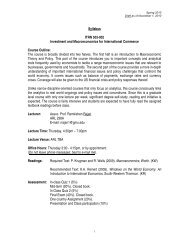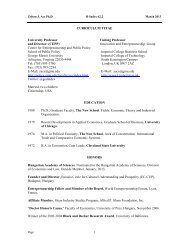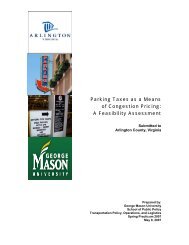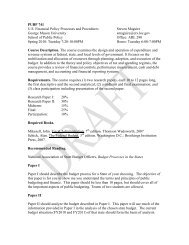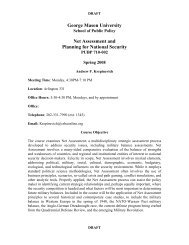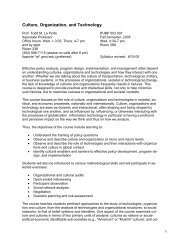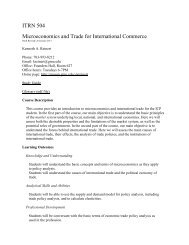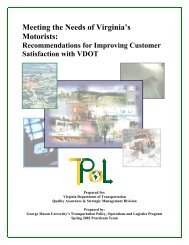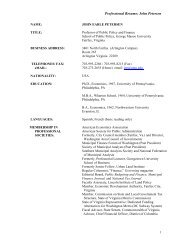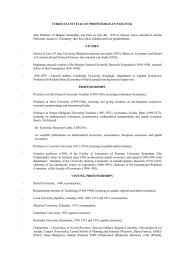Cost Benefit Analysis of Washington-Richmond High-Speed Rail
Cost Benefit Analysis of Washington-Richmond High-Speed Rail
Cost Benefit Analysis of Washington-Richmond High-Speed Rail
You also want an ePaper? Increase the reach of your titles
YUMPU automatically turns print PDFs into web optimized ePapers that Google loves.
<strong>Cost</strong> <strong>Benefit</strong> <strong>Analysis</strong> <strong>of</strong> <strong>Washington</strong>-<strong>Richmond</strong> <strong>High</strong>-<strong>Speed</strong> <strong>Rail</strong> Spring 2010<br />
38<br />
• The <strong>Rail</strong> Enhancement Fund - $25 million in annual funding;<br />
• Capital Project Bonds (CPB) - $113 million in capital project bond proceeds; and<br />
• 2007 Acts <strong>of</strong> the Assembly General Fund Appropriations - $65 million for specific I-95 corridor<br />
projects. 42<br />
In Florida, during the initial attempt in the 1990s to build HSR between Tampa and Miami, $70 million<br />
were appropriated annually for a similar rail investment fund, which was set up to support an<br />
infrastructure bond equal to $2.146 billion dollars. 43 It is assumed that, in a similar fashion, Virginia<br />
could use the dedicated annual $12.9 million in CPB funds, and $25 million annual REF to float a<br />
construction bond equal to $1.2 billion dollars, which is enough to cover the 70% match 44 . In California,<br />
debt service costs followed the market interest rates for major infrastructure projects <strong>of</strong> 7.5% annually<br />
to service a bond that covers a total build scenario for HSR infrastructure improvements for the entire<br />
Los Angeles-San Francisco corridor. 45 Both <strong>of</strong> these figures were used to estimate total construction<br />
cost debt incurred and debt service costs on a yearly basis for the length <strong>of</strong> the D.C.-<strong>Richmond</strong> project<br />
assuming limited federal support. These costs were separated out from the mandatory 30% contribution<br />
<strong>of</strong> public and private partners (VRE, Amtrak, CSX, the federal government, and local jurisdictions), which<br />
is required by the Commonwealth <strong>of</strong> Virginia to qualify for use <strong>of</strong> its REF and CPB funds. No further<br />
analysis was conducted to estimate the likely breakdown <strong>of</strong> contributions on the part <strong>of</strong> individual<br />
agencies within this consortium; however, it was included in a lump sum in a separate column in the<br />
infrastructure costs table.<br />
42<br />
Virginia Department <strong>of</strong> <strong>Rail</strong> and Public Transportation, “Virginia Department <strong>of</strong> <strong>Rail</strong> and Public Transit, Statewide<br />
<strong>Rail</strong> Plan Technical Update,” 8-4 - 8-8<br />
43<br />
Anthony Pearl, New Departures: Rethinking <strong>Rail</strong> Passenger Policy in the Twenty-First Century (Lexington, KY: The<br />
University Press <strong>of</strong> Kentucky, 2002), 71<br />
44<br />
Virginia Department <strong>of</strong> <strong>Rail</strong> and Public Transportation, “Virginia Department <strong>of</strong> <strong>Rail</strong> and Public Transit, Statewide<br />
<strong>Rail</strong> Plan Technical Update,” 8-1 - 8-4<br />
45<br />
Levinson et al., “The Full <strong>Cost</strong> <strong>of</strong> <strong>High</strong>-<strong>Speed</strong> <strong>Rail</strong> : An Engineering Approach.,” 194.



